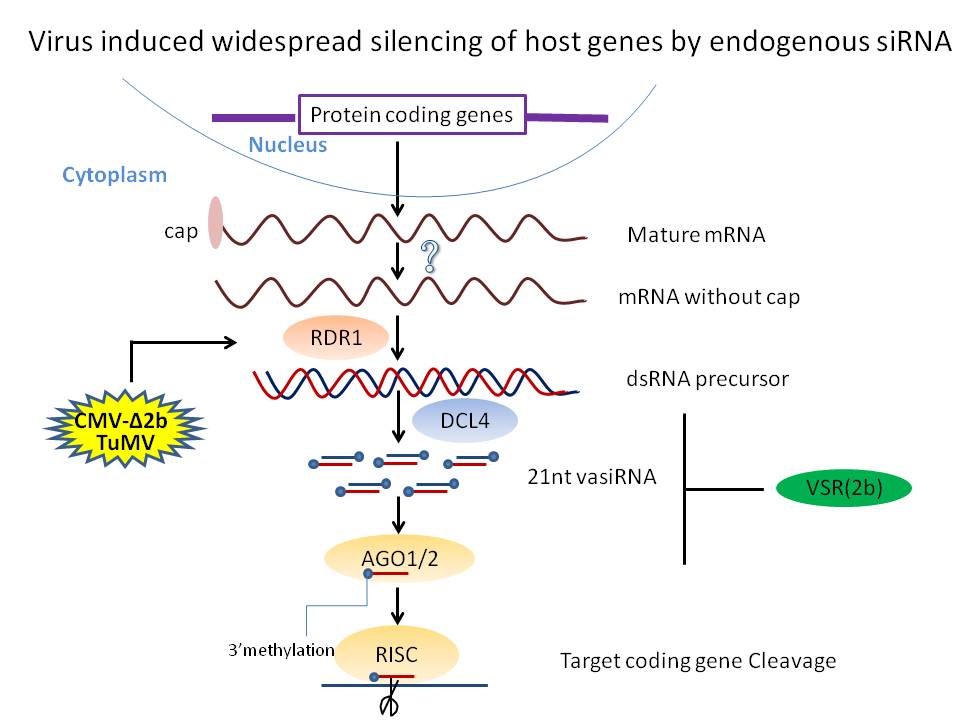PNAS:病毒和宿主之间通过基因沉默发生的相互作用新进展

已有的研究表明,由siRNA介导的基因沉默,是真核生物体内一种非常重要的抗病毒免疫机制。病毒侵染宿主后,宿主的基因沉默系统识别外源的病毒RNA,通过核酸内切酶Dicer切割并产生病毒的siRNA,来抵御病毒的侵染。病毒侵染是否能够诱导内源siRNA的产生,进而通过调控内源基因的表达起到抗病毒作用并不清楚。
在模式植物拟南芥中,已知不同的siRNA的产生依赖于不同的宿主基因沉默系统因子,其中抗病毒siRNA的产生主要涉及到DCL4,DCL2,AGO1,AGO2,RDR1和RDR6。该研究通过深度测序和生物信息学分析,发现了一类在两种完全不同的病毒,黄瓜花叶病毒(CMV)和芜青花叶病毒(TuMV)侵染拟南芥后特异诱导的,依赖于RDR1且长度为21nt的内源宿主siRNA。
进一步通过分子遗传学及生物化学分析,首次,明确了这类受病毒诱导的宿主内源siRNA的产生依赖于RDR1和DCL4,抑制內源基因表达依赖于DCL4和AGO2。两种完全不同的病毒(CMV)和(TuMV)病毒侵染诱导这类特异的具有抗病毒活性siRNA,说明这类siRNA具有广谱的抗病毒功能。本研究成果对进一步理解病毒和宿主之间通过基因沉默发生的相互作用从而更好地防治病毒有着重要的意义。
该论文的共同第一作者杜鹏为李毅课题组的博士研究生,李毅为共同通讯作者。该研究得到了丁守伟主持的多个项目、李毅和丁守伟共同申请的国家自然基金跨地区重大国际合作项目以及李毅主持的973项目的资助。
原文摘要:
Mengji Cao, Peng Du, Xianbing Wang, Yun-Qi Yu, Yan-Hong Qiu, Wanxiang Li, Amit Gal-On,Changyong Zhou, Yi Li and Shou-Wei Ding
Antiviral immunity controlled by RNA interference (RNAi) in plants and animals is thought to specifically target only viral RNAs by the virus-derived small interfering RNAs (siRNAs). Here we show that activation of antiviral RNAi in Arabidopsis plants is accompanied by the production of an abundant class of endogenous siRNAs mapped to the exon regions of more than 1,000 host genes and rRNA. These virus-activated siRNAs (vasiRNAs) are predominantly 21 nucleotides long with an approximately equal ratio of sense and antisense strands. Genetically, vasiRNAs are distinct from the known plant endogenous siRNAs characterized to date and instead resemble viral siRNAs by requiring Dicer-like 4 and RNA-dependent RNA polymerase 1 (RDR1) for biogenesis. However, loss of EXORIBONUCLEASE4/THYLENE-INSENSITIVE5 enhances vasiRNA biogenesis and virus resistance without altering the biogenesis of viral siRNAs. We show that vasiRNAs are active in directing widespread silencing of the target host genes and that Argonaute-2 binds to and is essential for the silencing activity of vasiRNAs. Production of vasiRNAs is readily detectable in Arabidopsisafter infection by viruses from two distinct supergroups of plant RNA virus families and is targeted for inhibition by the silencing suppressor protein 2b of Cucumber mosaic virus. These findings reveal RDR1 production of Arabidopsis endogenous siRNAs and identify production of vasiRNAs to direct widespread silencing of host genes as a conserved response of plants to infection by diverse viruses. A possible function for vasiRNAs to confer broad-spectrum antiviral activity distinct to the virus-specific antiviral RNAi by viral siRNAs is discussed.
作者:北京大学

